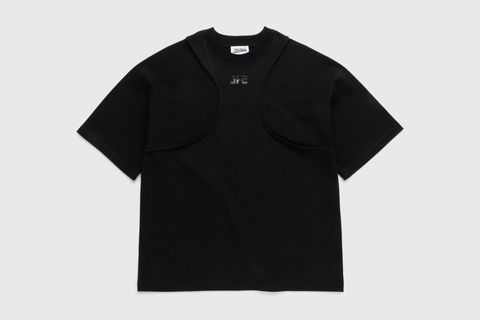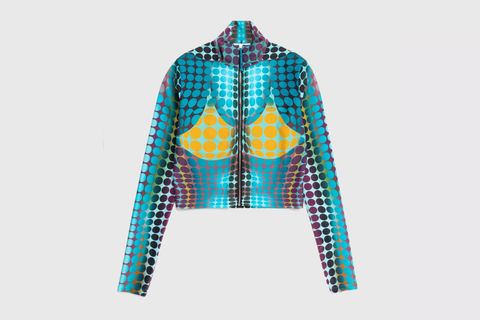In this FRONTPAGE interview from the new issue of Highsnobiety magazine, legendary designer Jean Paul Gaultier invites us into his Paris HQ and takes us through more than 50 years of his iconic career.
To warm up for our hour-long chat in his opulent Rue Saint-Martin headquarters in Paris, I ask Jean Paul Gaultier a few quick-fire questions. I’m curious how a living legend plays favorites with everyday mundanities like food (French toast), songs (Nile Rodgers’ “I Want Your Love”), and swear words (“fuck you”). In an innocent translation snag, Gaultier interprets my inquiry about his favorite possession as his favorite position.
“In which way? Sexual?” he asks, without flinching. I invite him to answer however he’d like. “Any that I haven’t tried!” he laughs.
When the initial question is restated, he answers: “I know it’s easy to say, but freedom. Freedom to do what you want without imposing on the freedom of others.” And before we’ve even properly started, Monsieur Gaultier has recapitulated in brief the prolific creative formula — liberty, inclusivity, and just the right amount of smut — that carried him to his 50th year in fashion in 2020.
It should be stated that 50 is not entirely accurate. At the age of 70, Monsieur Gaultier has been creating since the age of six. Growing up in the Parisian suburb of Arcueil, he cut out newspaper pages, curled them into cones, and fixed them on his teddy bear, Nana, whom Gaultier calls “the world’s first transgender bear.” The result was the first iteration of the infamous cone bra he would go on to make for Madonna’s “Blond Ambition” tour in 1990.
After starting his eponymous label in 1982, Gaultier became the enfant terrible of the Paris fashion scene. His deft technical abilities, honed in the ateliers of Pierre Cardin and Jean Patou, proved scandalizing when used to realize couture inspired by underground nightlife, New Wave, punk, and the sexual politics of the time. Many of his garments were made from garbage bags, wetsuit neoprene, and distressed denim. Some of his most iconic contributions include his signature marinière, the Breton-striped blue and white knit he wore as a boy, tattoo prints, the “bullet” cone bra, and the men’s skirt. He was one of the first openly gay designers and exalted models of various sizes, ages, skin colors, genders, and sexualities.
In 1989, Gaultier made his first foray into costume design, working on Peter Greenaway’s film The Cook, the Thief, His Wife & Her Lover, starring Helen Mirren. He would go on to work on Pedro Almodóvar’s 1993 film Kika, 2004’s Bad Education, and Luc Besson’s technicolor sci-fi epic The Fifth Element in 1997, while simultaneously outfitting Madonna for three world tours, releasing multiple ready-to-wear and couture collections, and launching a fragrance empire.
To mark his 50th anniversary working in fashion, Gaultier threw a spectacular swan song at Paris’ Théâtre du Châtelet in 2020 with former first lady Carla Bruni sitting in the first row. It also marked his final collection for the label that bears his name as he has invited a rotating cast of guest designers, including Chitose Abe of Sacai, Glenn Martens of Y/Project, Olivier Rousteing, and Haider Ackermann, to reimagine the couture archive.
“I have opened all my drawers, taken back all my old collections. I have used my archives as material,” he explained in his farewell show notes. “Goodbye, the brand-new; hello, the brand old. What I did at the beginning with no resources, I do today with my inheritance to give life to new creations.”
However, the designer hasn’t quite finished. He continues to dabble in cabaret, working as a costume designer and scenographer for the Friedrichstadt-Palast in Berlin and ensuring his autobiographical theater production, Fashion Freak Show, continues its world tour.
“Even if I’m not asked to do something, I can work like I did as a little boy, making sketches,” he explains. “It’s innocent in that it’s creation for creation, without the need to make something commercial.”
Let’s start simple. What’s your favorite color?
Mixed.
What’s your favorite film?
I should say Falbalas, the movie that inspired my work. If not, I can add [Federico] Fellini’s La Strada, which is a beautiful old movie.
Favorite song?
“I Want Your Love.” The musician who did the song for Fashion Freak Show! Who was it?! Oh la la, the shame! He’s a guitarist. Nile Rodgers!
Favorite city?
That’s difficult. I can say where I go often is the southwest of France, Saint-Jean-de-Luz, which is close to Spain. It’s traditional. It’s stayed how it was when I was a child. It’s calm and simple and not at all fashionable.
What about your favorite restaurant in the world?
In Paris, let’s say Takara, which is Japanese. I have to go back there!
Who is your favorite designer, living or dead?
There isn’t only one. There is Pierre Cardin, who opened his door to me without me having any fashion education. I sent him my sketches, and he took me without any qualifications or recommendations. I also love [André] Courrèges and [Yves] Saint Laurent — and also [Coco] Chanel! Each of those, they revolutionized fashion construction and also the spirit and politics of fashion.
Chanel arrived and took revenge on all the women that were with [Paul] Poiret, who were very luxurious and so on, [and put them] in a black dress with a little white collar and cut their hair. Courrèges was somebody with style and he made women models. I remember I saw an interview with him where he said, “I do it for the woman that will drive, that will go on a bicycle…” A modern woman. With Saint Laurent, he was following the sexual evolution, so the modernity of the end of the ’60s and ’70s — even making his own hippie movement. He was very of the moment, very social, which I admired. I think that’s the essence of what we have to do.
What has fashion come to mean to you?
Fashion is reflection: How is society? How is the world? Today, ecology is a [huge consideration] because of the need. But, if I may say, I was lucky in that I was feeling it, not thinking. It was free. It was a moment where sex was more liberated. In 1968, in France, it was a revolution from the young. Mentalities were changing, and I was a little part of that.
What was a formative fashion experience?
One time, I saw Folies Bergère on the TV and made a sketch of [one of the dancers] with fishnets and feathers. My teacher [saw it] and made me stand up, put it on my back, and do a tour of the other classes to humiliate me. But [what happened was] the contrary! I was a little rejected because I couldn’t play football, for example, but because of my sketch, people would ask me to draw for them.
After more than 50 years in fashion, what do you do with your excess ideas?
In a sense, doing a collection [is like] when athletes do sport. They make muscles. For me, it’s muscles in my mind, to create with. So I work with the Palast in Berlin and that kind of thing. It’s good, because it comes out as a show, but it’s not fashion. Sometimes I still sketch and think, “Oh, that’s a good concept for a new collection!” and I forget. But I know that I don’t want to do a collection anymore.
What does family mean to you these days?
My parents have passed away, so my family is the friends that I’ve made by working, with whom I have some affinity. And I should say, not people of fashion, especially.
Is it true the furniture in this shoot is from your first boutique?
They were in my first boutique, yes, the pieces in green. They were a change room, which used to be a pissotière [urinal] where you can pee. They were outside in Paris!
So Madonna…?
Yes, she went to the pissotière! But she was taking off her clothes [out in the open].
Madonna, Sting, Boy George used to come in and choose their own clothes, and now the process is different. Do garments have the same meaning as they did when you first began?
Oh, it was great, fabulous. You know, I am too shy to ask, so the fact they came in, people I admire, I was very lucky. For me it has been incredible, like, I never had to ask. I take it as a compliment. I was, of course, since the beginning, admiring Boy George, his voice and his look and, in general, British rock had an influence on me. At the time, there were a lot of streets in London that were very exuberant and very creative. It gave me energy because at the time Paris was not the same. The English know how to have fun.
Do you still go to nightclubs?
No. But to be honest, I was going less to nightclubs that were for dancing...
What is the future of fashion?
There is no way to think about the future of fashion. It will be what will be necessary for the people at the time. It is a reflection of what people need, and how they want to make their desires come true.
How do you choose your collaborators?
I chose people who already have a body of work — not a new designer, because they have to bring something of themselves. That’s why I chose Chitose [Abe], because she brings her culture to her work, and why I chose Haider Ackermann. I love what he did, because I like to put different things together, where he is very minimal. With Olivier [Rousteing], he did it like an homage, in his way, and pushed things, so I’m very happy to see that. I am excited to see somebody that brings something else, it creates an evolution. For me, it’s very flattering that they accept to do it.
Who’s going to say no to you?!
There are some!
What’s it like seeing your fashion DNA in the hands of others?
It flatters me. It’s the best thing. Jean Paul Gaultier is a label — a house — and I like the idea that it will still be there in the future. Not [necessarily] under my name. It’s not a personal thing.
I had the idea a long time ago when I worked at Jean Patou, after I made my first collection. I thought I would like to make a collection for Jean Patou because I was only an assistant at the time. I was thinking maybe it could be good that I do one, and Vivienne Westwood, Mugler, for example, and each season [Patou] could make one or two collections with each designer. I went to see the heir of the [Jean Patou] house and told him my idea and his first answer was, “It will cost too much.”
But I think it’s a nice exercise. I remember when I was at Hermès [Gaultier was creative director from 2003 to 2010], it was the opposite of myself. I was more punk than I was Hermès! After I saw Martin Margiela, who did Hermès very well, I was thinking, “What should I have done?” But it was more just to enjoy and have a new experience.






